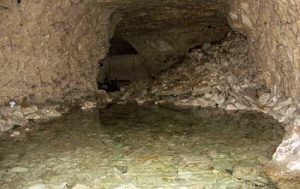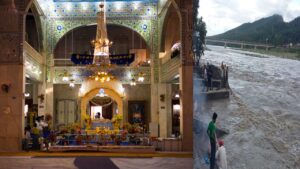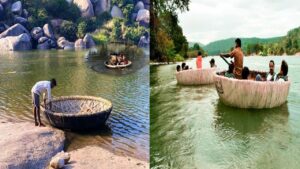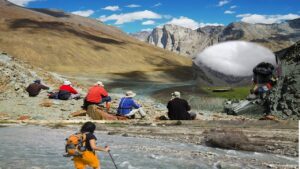Chislehurst Caves- World Of Wonder
Chislehurst Caves, the little-known underground wonder of London
There is an almost magical place lying in the British capital. A little known series of tunnels form a cave complex, which is located in southeast London and is a place where mystery meets history.
One can’t help the feeling that anything could happen in a cavern. Who knows what lies ahead in the dark? It might be something horrible, as well as something wonderful. This sense follows the visitor who has the chance of leaving daily routine behind and entering a world of wonder.
Such a world of wonder is Chislehurst Caves.
The Caves feel like a time capsule for English history: from the druids to the Saxons, to World War II and… Dr. Who, the Chislehurst Caves have lived through all of it and are a fascinating attraction for history lovers.
What are the Chislehurst Caves?
Despite being called the “caves”, the truth is that the tunnels are man-made. Located in suburban southeast London, within the London Borough of Bromley, they were used in the past as a mine for chalk.
They reach a depth of about 100 feet and cover an area of 22 miles (35 kilometers, the size of six rugby fields). Only a small section is accessible to the public (one out of the 22 miles), offering a chance to visitors to think about the… unimaginable mysteries that could lie in the galleries ahead.
A rich history
The Caves resemble a labyrinth. They were dug in medieval times for chalk used in lime burning and brick-making for the building of London. They were also used for flints to fire the tinderboxes and flintlock guns. Some believe that the tunnels were dug on a pre-existing site -from Roman ages or perhaps older.
There is a debate on how old the Caves are. It is believed that they go back to the time of the Saxons-around 400 A.D. Some even think that the older parts of the caves were built by “druids” -maybe it is more accurate to talk about Neolithic Britons and not the cast of mystics we usually think of when we hear the word druid. From the early 20th Century, tour guides chronicled parts of the cave between 6,000 and 4,000 years old. Today, some archaeologists dispute the claims, saying that there isn’t enough evidence to support them.
The first one who wrote about the ancient origins of the caves was Dr William Nichols who in 1903 published the first paper on the cave in the Journal of the British Archaeological Association. A second paper would soon follow. His theories were later disputed -and they were people that turned against the man himself, calling him an eccentric. However, his theories became extremely popular and still live on today.
In the Caves there is also a well that is claimed to be of Roman origin. The well is thought of being used as a wishing well. It was filled with rubbish by shelterers who lived in the Caves during World War II, but is still one of the attractions included in the tours. Tour guides inform the visitors that the Romans used the chalk from the mines in order to build roads, as well as part of the London wall.
Another disputed part of the Caves’ history is connected to Napoleon. It is thought that Napoleon III used as his lodgings and storehouse part of Chislehurst, just a short walk from the Caves. AlthoughNapoleon’s presence in the Caves possible, this theory can not be proved.
In fact, the first recorded mention of the Caves comes from medieval documents (circa 1250 AD) and there are also mentions in post-medieval church records of 1737 AD.
In the 1830s the mine was abandoned. Later, a railway was built, making it easier for people to reach the area. It was not until the beginning of the 20th Century that another use was found for the Cave: it became a minor tourist attraction and visitors paid a small fee to see the Caves and listen to popular stories about druids, Saxons, and Romans.
During the First World War, the Chislehurst Caves were used as a munitions storage for the Woolwich Arsenal. The cool, damp conditions in the caves made them suitable for the storage of explosive material and it was thought that the destruction would be limited in the unfortunate case of an accident.
At that time, a narrow gauge railway was built, so that boxes filled with explosives (such as TNT) could be taken underground by small trains pulled by battery-powered locomotives.
After the war, the army left the Caves and in the 1920s and 1930s, the tunnels were used as a mushroom farm.
Shelter during the Blitz
It was a mushroom grower, called James Geary Gardner who took a life-saving decision: to open the Caves to Londoners who tried to escape the severe air-raids (known as the Blitz) that the Nazis launched during World War II.
At first, the Caves were used as a temporary shelter. But by 1941 things got a lot more organized. There were not many facilities that could offer coverage to people in the center of London, and most of the capital’s citizens tried to find refuge in Tube stations. The Caves seemed like the best solution for people trying to avoid death.
It is estimated that the Caves helped to protect thousands of people. They were used as a private shelter and during that time had a nightly population of about 5,000 people, a number that swelled to 15,000 people by the end of the war, when the bombing was severe.
It is said that when stray bombs landed in the woods above the caves, almost no one living underground noticed a thing -other than the occasional flicker of lights.
Each person paid a penny -a-night and had access to toilets, a bed and washing facilities. There was also a team working as a “sanitation squad”, emptying the latrines.
For some families, the caves were not a temporary measure, but a place they could call home. A lot of houses were destroyed in London during the air – raids, so people had no choice but to live underground. Every morning, those staying at the shelter went to work, children went to school and later in the evening trains and coaches brought them back to the Caves for one more night of safety.
The population of the Caves had a self-organized system that made the lives of the shelterers better. An underground church popped up, as well as a small hospital. The hospital was, in fact, a Medical Aid Unit run by the Red Cross, but it was considered a really good facility, managing to save lives in dark times.
The people living in the shelters also had access to electricity, running water and an air ventilation system. By 1941, one could find in the tunnels a cinema, a barber, dance halls, a gymnasium, three canteens (with people queuing every evening with their teapots), a local shop and a police station (but no school). It was a vast underground city in times of need.
In October 1940 the Rector of the local parish church sought volunteers for the kitchen: “The migration to the Caves has brought to our doors a splendid chance of service…
The caves were managed by a committee and there were also volunteers, called “cave captains” that were elected in order to ensure that the rules and codes of the bunker would be followed. Visitors can still read the rules on a board in the Caves (there are codes such as “No furniture admitted” or “Four days absence may involve loss of pitch”).
The population of the shelters had to stop music by 21:00 and they were prohibited from lighting stoves. There was also a 21:30 curfew that was not strictly enforced.
The cave captain also took care of the nightly population and was in charge of spaces that hosted 60 to 100 shelterers.
Must Read:- Elephanta Caves
Swinging Caves
After World War II, the Caves returned to their old use and became a tourist attraction. Gatherings were also organized and people who used to live in the bunker would also visit.
However, as times changed, so did the Caves. After being used as a shelter for civilians, they were caught up in another part of British history… the Swinging Sixties.
During the decade, a stage was built and the Caves were used as a venue for concerts and dances. Imagine watching music legends such as Jimi Hendrix (he performed there twice), The Who, the Rolling Stones and Pink Floyd playing music in such a mystifying location.
On Halloween of 1974, a lavish media party was held in the tunnels, in order to celebrate the launch of British record company Swan Song Records. The band that performed during the event was none other than legendary Led Zeppelin.
Today, an empty stage stands in memory of the rock n’ roll tunes that echoed through the tunnels. There are people who think that it is a shame that the practice of musical concerts has not carried out until today.
Chislehurst Caves in popular culture
There is another part of English history that is associated with the Caves and that is their appearance in popular culture. One of the Caves’ inhabitants is none other than Britain’s favorite doctor: Dr. Who.
The tunnels have featured in “The Mutants” (1972), a six-part story of the famous sci-fi TV series. In these episodes, the Doctor Who (played by Jon Pertwee) and his companion Jo arrive at Skybase One during the 30th century when planet Solos is fighting for independence from Earth. Chislehurst Caves are used as the inside of Solos’ caves.
Doctor Who is not the only show that was shot in the same tunnels and caverns.
Filming dates back to the late 1950s with parts of Jazz Boat and Beat Girl being filmed in the Caves.
In May and June of 1980 saw the caves become a distant planet for the feature film Inseminoid. Parts of Bliss, Neverwhere, and Randal and Hopkirk Deceased, as well as most of the subterranean scenes in the popular BBC series Merlin (2008), were filmed in the caves.
The caves have also been used for numerous short films and pop videos. Also, the Christmas edition of Wartime Farm was filmed there on 19th October 2012. Most recently, Fungus the Bogeyman with Timothy Spall and Victoria Wood 2015, The Tracey Ullman Show II, Electric Dreams Phillip K. Dick (Human is) in 2016 were filmed at the cave.
The Caves have been also used as a location for Vinnie Jones film The Riddle.
Some are also connecting Chislehurst Caves with a legendary figure in English Literature. We are referring of course to playwright William Shakespeare. In the Caves, one can see carvings by an unknown sculptor that some date to the Elizabethan era. One of the aforementioned carvings is believed to depict the bard himself. Some also claim that during his stay at Scadbury Hall, Shakespeare visited the Caves. He might have also drawn inspiration for some of his plays. Again, although it is possible, there is no evidence to support this.
Mysteries of the Cave
Every good cavern must have its fair share of mysteries and horrors. Chislehurst Caves are no exception, with guides telling visitors tales of murders. There is, of course, the rather predictable ghost that a lot have claimed to see.
The Chislehurst Cave ghost is believed to be a woman who is thought to have been murdered by her husband in the Caves -the story tells that she died after she was pushed in a lake, the so-called Haunted Poll. Strangely enough, the place of the murder is thought to be one of the few places in the tunnels without echo.
There are rumors of sightings of a lady dressed in white floating over the Haunted Pool. A few years ago, the Caves used to organize a challenge: every person who would succeed in staying inside Chislehurst Caves for a whole night would win a money prize. This challenge stopped when the last man who tried, was found unconscious in front of the doors leading to the ticket desk -or so the rumor goes. He was thought to have suffered an epileptic crisis, although he later told the story of seeing the cave’s “ghost”.
The ghost is not the only paranormal phenomenon that is connected with the Caves. There is even a 100-page e-book about the “ghosts of Chislehurst” that you can read if you want to be ready for a paranormal encounter, before your visit.
Geological interest
Geology lovers will also find interesting things in the caves. It may not have the wealth of stalagmites found in natural caves, but visitors can also see stains on the walls, which are caused by the minerals (iron and copper) which seep through the chalk with water.
Some guides show the fossilized remains of an Ichthyosaurs, although most admit that those are just a large piece of flint. So, it seems that there are no dinosaurs, unfortunately.
The walls are indeed made of chalk and visitors can see caricatures carved on them -such as sketches of Hitler, probably drawn during the period of the Blitz.
What to see in Chislehurst Caves
During the 45 minute tour, visitors will get their own Oil Lamp, and follow the guides that offer a range of attractions to see in the Caves.
So, here are just some of the things that visitors will have the chance to see during their visit:
- The map room. There you can see a sketch of the full extent of the Caves. Only a small section can be visited, though the tunnels run for miles.
- The reconstructed church, as well as lodgings, called the “pitch” (there you can see beds, lamps, furniture and a curtain that its aim was to give more privacy to the family staying in the pitch) offer a closer look to the everyday life of the shelterers during World War II.
- A reconstruction of a cavern that was used as a munitions storage room shows two wax statues of soldiers guarding explosives during World War I.
- The intricate carvings inside the Caves. Some are modern, others are older. A lot seem like they came out of Lovecraft’s literary universe. Those carvings are great for photos that you can upload to your Instagram account.
- The Haunted Pool seems like an ordinary pool of water but it is said to be the “home” of a ghost lady wearing a white dress. Try to spot the ghost that has become part of myth and legend.
- The Druid Altar. Although the presence of druids in the Caves is not confirmed, visitors can see the Druid Altar, which is thought to be one of the ceremonial temples (there are nine in total) in the Caves. Professor Nichols believed that on a midsummer night’s eve a number of Druids would go into one of the nearby villages and select a victim between 10 and 14 years old (boy or girl). Then, they would bring the victim down into the Caves and into the temple and tie them to a block of stone. They would sever the jugular vein in the victim’s neck with a bronze knife, collecting the blood in a small goblet. Then, the druids would offer the blood to their gods, while the druids would dance and chant, wearing ceremonial robes. Although the claims of professor Nichols cannot be proved, the story is fascinating.
- Best free streaming sites updated list for 2019 free movie sites online
How to reach
The Caves are a short walk from Chislehurst Railway Station, which is only 30 minutes from London Bridge. The entrance can be found in Caveside Close near the “Bickley Arms” public house.
By Road: You have to go A222 between the A20 -A21. At the railway bridge by Chislehurst Station, turn into Station Approach, turn right at the end then right again into Caveside Close. if Using a Sat-Nav, the postcode BR7 5NL will put you at the entrance to Caveside Close.
By Rail: There are regular trains to Chislehurst from Charing Cross and London Bridge, from the station turn left into Station Approach and follow the above directions.
By Bus: to Chislehurst Railway Station The 269 runs between Bromley and Bexleyheath and the 162 between Beckenham and Eltham.
How to visit
Chislehurst Caves, Old Hill, Chislehurst, Kent BR7 5QX (020 8467 3264; chislehurst-caves.co.uk) open Wednesday to Sunday, Bank Holidays and daily during school holidays, 10 am to 4 pm.
The Caves offer a range of tours and can be used as a venue for parties and gatherings. The visitor center includes a café, a gift shop, picnic area, and a free car and coach park.
Most of the Caves are unlit, and all of the tours are conducted by lamplight, the Hurricane Lanterns used for this purpose are very atmospheric. The use of lamps is one of the hits of the tour, helping visitors to travel back in time and live the experience of staying underground for hours or days.
Tours run every hour and last 45 minutes. Adult groups can have their own private 45/50 minute tour at a rate of £6 each (minimum charge £90, seniors/children £4 each, minimum charge £60). There is no need to book except groups over 15. There is access for wheelchairs and mobility scooters.
Children’s group tours must be booked in advance. The tours which last for around 45/50 minutes cover many aspects of the Curriculum, from simple Light & Dark, Rocks & Soils, Stone Age, Roman, Saxon right up to the Second World War. These groups will have a guide to themselves and the visit can be customized for the group’s specific interest (for example tours focusing on history or geology etc.) All groups should pre-book at least 7 days in advance.
School groups enter the Caves at fifteen minutes past the hour.
Evening Tours Caves open at 7 pm; tour starts at 7.30 pm and lasts for approximately 90 minutes (the time is negotiable within reason). Cost is £12 per person and a minimum charge of £360 will apply to groups of fewer than 30 people. A £60 deposit is payable upon booking, and a minimum of two weeks’ notice is required. Meals, anything from a buffet to a three-course meal in the Caves Restaurant, can be provided. The evening tours are strictly for private groups of up to 50 people.
There is also the possibility of hosting children’s party tours (for ages 8 or above). Children and parents can hear spooky stories and explore a few low tunnels during a private tour. Children can then enjoy a buffet meal in the Caves Private Function room. Parties can be booked for weekends or School Holidays and a £10 deposit (without food) or £20 (food) is payable upon booking. Tours go into the caves at 11.15 am or 2.15 pm, pick up times are 12.45 pm and 3.45 pm respectively.
You can also gain access to Chislehurst Caves, using your London Pass (if you have one).
Useful information about your visit
So, what does one wear in a cave? Sensible footwear (boots or trainers) are recommended, stilettos are definitely not advised (even for the ladies). Otherwise, standard clothing is fine, but remember, in summer the caves are much cooler than outdoors.
It is possible for a wheelchair to enter the caves with a suitably strong pusher, but due to the uneven floor surfaces in parts of the caves it can be quite hard work and it will be a bit of a rough ride.
Animals are, of course not allowed in the caves. However, Guide or Hearing dogs are allowed.
Visitors can take photos or videos during the first part of the tour in the lit areas. Once you go into the dark you will need to put those cameras and mobile phones away, since thoughtless use of flash can cause temporary blindness in the darkness of the caves.
The caves are a constant temperature of 10 degrees Celsius (50 degrees Fahrenheit) all year. Visitors may find them a little chilly in summer, but quite warm in winter.
The ticket office houses a cafe and a small gift shop. The location brings to memory and old fashioned railway station waiting room. Tall ceilings, wooden benches and old photographs from the area can be seen hanging on the walls. There is also a TV screen that offers a glimpse into local history.
Where to eat
The Caves Cafe
Visitors of the Caves often comment favorably on the food offered by the Cafe in Chislehurst Caves. It offers breakfast and lunch and it is ideal for everyone loving a good old English breakfast.
Chislehurst Curry & Grill
Asian cuisine that offers what the name says: great curry. It is located on 53 Chislehurst Road, very close to the Chislehurst Caves.
The Bickley Pub and Steakhouse
If you crave for British food, look no further than the Bickley pub and steakhouse. It has a big beer garden and offers decent food. You can find a range of dishes and fish and chips is one of the favorites (Chislehurst Road).
Bridges Fish and Chips
If you want a quick snack before you visit Chislehurst Caves, then Bridges Fish and Chips is ideal for you. It offers quality fast food, a British classic that locals and tourists prefer (49 Chislehurst Road, Chislehurst).
Denny’s Seafood Restaurant
For lobster, scallops and crab dishes Denny’s Seafood Restaurant is the place to be. It has gluten-free options. It’s great for train lovers since it is situated inside the former waiting room of the Chislehurst train station (3 Station Approach, Chislehurst).
Where to stay
The Crown Inn
Located just 1 mile from Chislehurst Railway Station, the Crown Inn offers 4-star accommodation with a bar, restaurant, and modern en suite rooms. Some rooms have beautiful views of Chislehurst Common. (School Rd, Chislehurst BR7 5PQ).
The Bulls Head Hotel
Set within the village of Chislehurst has a cozily furnished rooms with Freeview TV. It has both a restaurant and two bars.
Bromley Court Hotel London
The Bromley Court Hote is spread in an area of 2 acres,10 miles south-east of central London. It has a view of London and Kent countryside. It offers free WiFi and free on-site parking (Bromley Hill, Bromley, London BR1 4JD)
The manor at Bickley
The Manor at Bickley is nested in 6 acres of landscaped gardens, offering accommodation in Bromley. It can also be the setting for a social event (for example a wedding) or for a business meeting (The Manor, Thornet Wood Road, Bickley).
Glendevon House Hotel
The hotel offers accommodation in Bromley. It is a 3-star hotel with a 24-hour front desk. Free WiFi is available. (Glendevon House Hotel, 80 Southborough Road, Bickley, Bromley)
Other attractions in Chislehurst
You visited the Caves, but want a full day experience at Kent? No worries, there are plenty of things to see and do in the area.
Chislehurst Commons
There is no wildlife in the caves, but you can see rare species of plants, birds, reptiles and small mammals in the nearby Chislehurst Commons, which are 180 acres of woods and grassland. Ideal for walking, running, spending time with the family, the privately owned Chislehurst Commons has a parish church, several ponds, and a cricket ground. Throughout the year they are home to several events.
St Nicholas Church
Located in the center of Chislehurst Commons, part of St Nicholas Church dates from the 15th century. You can also see the Walsingham Tomb, in the north-east corner of the chapel. The tomb has front panels of intricately carved ‘decorated’ work, perhaps reused from an older tomb. Outside the church, there is a circular piece of land, -known as “the cockpit”, which was used for cockfighting until 1834. In later years it became a village landmark and was used in the First World War for the homecoming service for the troops.
Royal Parade
Near St Nicholas Church, also in the Commons, visitors can find the Royal Parade, a raw of shops built in the 1860s. The “royal” comes from Napoleon III, who used to live nearby. Nowadays the buildings are used as a home for shops, cafes, and restaurants. You can find designer boutiques and even a spa!
The Green Chain Walk
Another must-see for nature-lovers, the Green Chain Walk is 50 miles in length and features rivers, parks, and fields with silver-leaved woodlands. Chislehurst is one of the starting points and visitors can walk the Thames riverside and reach Woolwich, Thamesmead or Erith.
Eltham Palace
Once a medieval palace, then a Tudor royal residence, Eltham Palace was transformed into an Art Deco mansion by eccentric millionaires Stephen and Virginia Courtauld. Their home incorporates original medieval features in an ultra-modern 1930s design. Eltham Palace is a 10-minute drive from Chislehurst and visitors can also enjoy the 19 acres gardens and see a play area inspired by the Courtaulds travels around the globe.













